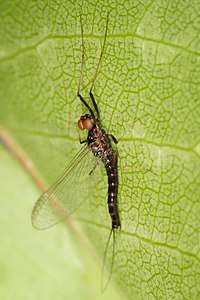Leptophlebiidae
Leptophlebiidae is a family belonging to the Ephemeropterans that are commonly known as the prong-gilled mayflies or leptophlebiids. It is the only family in the superfamily Leptophlebioidea.[1] In North America they occur with about 70 species from 9 genera in freshwater streams and lakes; in Europe they are somewhat less diverse. Globally, this family is much more prevalent and diverse, with about 2000 different species. Leptophlebiids are easily recognized by the forked gills present on the larvae's abdomen, thus their common name.
| Leptophlebiidae | |
|---|---|
 | |
| Male imago of undetermined Atalophlebia species from Swifts Creek, Victoria (Australia) | |
| Scientific classification | |
| Kingdom: | |
| Phylum: | |
| Class: | |
| Order: | |
| Superfamily: | Leptophlebioidea |
| Family: | Leptophlebiidae |
| Genera | |
|
Numerous, see text | |
Larvae
Leptophlebiid larvae live in freshwater streams and lakes eating detritus and/or algae. North American species generally cling to rocks, few physiologically equipped for skilled swimming. Like all Ephemeropteran larvae, fragile gills line the lateral margins of their abdomen. Some genera grow mandibular tusks like their burrowing relatives, the Ephemeridae, Polymitarcyidae, and Potamanthidae.
Selected genera
- Acanthophlebia Towns, 1983
- Atalophlebia
- Choroterpes
- Farrodes
- Habrophlebia
- Habrophlebiodes
- Leptophlebia
- Miroculis
- Neochoroterpes
- Paraleptophlebia
- Thraulodes
- Traverella
References
- "Ephemoptera: Mayflies". The Tree of Life Web Project. 2002. Retrieved 2015-05-31.
External links

